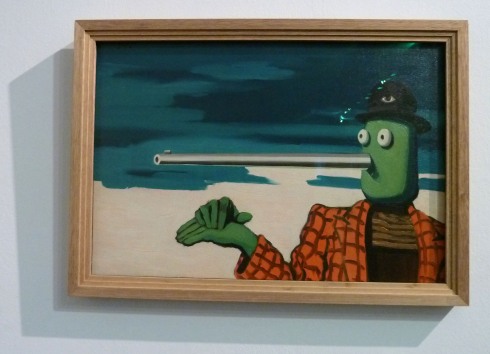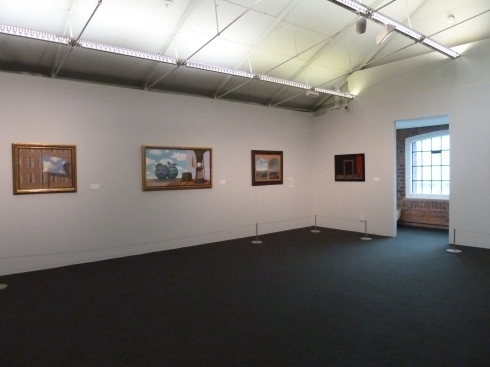Last time I visited Tate Liverpool was in 2007 to see their Chapman Brothers’ exhibition and I was excited to return to have another look in the gallery. René Magritte: The Pleasure Principle confirms my previously mentioned opinion that Tate bought a bargain job-lot of grey paint and is going mad with it. The opening room is so dark and gloomy that you don’t actually want to look at these masterpieces. Instead, you want to hurry through to find the light.
Own photograph.
Magritte’s works are iconic. His interest in evoking mystery dominates most of his works, exploring the disturbing effects of depicting recognisable and familiar objects in unfamiliar environments. The works make use of visual repetition and the paintings themselves are also repetitive. Magritte regarded that his role as an artist was to confuse and displace; he often makes it hard for viewers to know what they are looking at, a method enhanced by his sometimes bland painting and commercial expressionless, advertisement style.
René Magritte, The Listening Room, 1958. Own photograph.
I am normally a firm believer in the importance of seeing works first hand but Magritte himself did not think this was necessary saying there is ‘very little difference between seeing a work in reproduction and looking at the real thing.’ That is usually not the case but it is for Magritte’s where I think the concept is more important than the paintings themselves. He often churned out many of the same works; when seen individually, whether ‘in the flesh’ or in reproduction, they are amazing but when seen in bulk they blur into each other and lose significance.
This is the most comprehensive Magritte exhibition ever staged in the UK with over 100 loans from private and public collections, including works that have never been exhibited before. The paintings are arranged thematically, showing different elements of Magritte’s practice but I found some sections to be disjointed.
His Vache paintings are silly works with a strange humour (Vache, literally meaning cow, was a pun on Fauve or ‘wild beast’ and was the name given to artists associated with the Fauvist movement at the beginning of the 20th century). Ellipsis is the strongest in this section, showing a green headed man, wearing a Magritte-style bowler hat (with an eye staring out from its crown) – his nose is a rifle, his left hand is detached from his arm, his eyes are cartoon-like and the colours are garish. Magritte’s Vache works are flamboyant in their caricatured style and uncharacteristic in his oeuvre; the artist utilises his paint in an unusually sloppy and painterly fashion, challenging conventional expectations of taste.
René Magritte, Ellipsis, 1948. Own photograph.
The exhibition includes such well-known paintings as: The Lovers (1928) whose shrouded heads perhaps recall the horror of Magritte’s own mother’s suicide when the young Magritte witnessed his mother’s drowned body being pulled from a river, her face veiled by her nightdress; Threatening Weather (1929) bearing the hallmarks of an unsettling, possibly erotic dream; Time Transfixed (1938) where a train travelling at full speed emerges from a fireplace and; The Treachery of Images (1935), more familiarly known as Ceci n’est pas une pipe, (don’t miss it, it’s hidden by a doorway) of which he made many versions, all of which have received an inordinate amount of study and analysis. The pipe, in fact, became the most emblematic of Magritte’s banal images.
René Magritte, The Treachery of Images, 1935. Own photograph.
The sheer quantity of the loans does mean there are some exciting works with which I wasn’t familiar. The Secret Player (1927) is one of his first truly Surrealist works, establishing many familiar techniques: depicting objects in contrasting sizes, the metamorphosis of the inert into the living, the suggestion of staged performance behind a curtain and the presentation of the ordinary in extraordinary circumstances. Here, it is a cricket match amongst skittle-like bilboquets which evolve into trees. The work is unsettling and confusing – why is that turtle floating overhead? There is a lot of misery and unpleasantness in Magritte’s world, it’s not all jolly transformations of fruit.
René Magritte, detail of The Secret Player, 1927. Image via www.guardian.co.uk.
My favourite work is a piece I hadn’t seen before. Crouch down in the corner of the first room and spend some time with The Cut-Glass Bath (1949). I’m not going to ruin its elegant simplicity with words – it’s beautiful but, of course, the subject of capture and imprisonment is not.
René Magritte, The Cut-Glass Bath, 1949. Own photograph.
I am ashamed to admit that half way through the exhibition I gave up on my heels and had to change shoes, shrinking several inches in the process. I had gone up to Liverpool for meetings at the Contemporary Urban Centre (a wonderful space) and having already walked for most of the day, my feet had had enough. There is only so much one person can take and the greyness of the walls made me feel drained. Awful I know! Don’t worry, I was back clacking today.
The exhibition does improve drastically in the second half. ‘The Pictured Picture’ room playing with the idea of hidden visibles holds some gems. The sketches are interesting and unusual to see, as Magritte proposes a three-way relationship between text, image and reality. There are also some rarely seen photos by Magritte as well as a room devoted to his commercial works – advertising posters and the like.
The Pictured Picture. Own photograph.
The exhibition was far bigger than I had expected, too big in fact. You go round wanting not only to see the famous pieces but they’re famous for a reason and, amidst this confusing mass of work, you find yourself easily drawn to the familiar.
Now, it may not come as a surprise if I reveal I have a thing for the Thomas Crown Affair. Of course, this is entirely due to the inclusion of my favourite Magritte painting and nothing to do with Pierce Brosnan! Although reproductions of the man in the bowler hat recur frequently in the shop, The Son of Man (1964) is in private ownership and not included in the actual
exhibition. Other Magritte paintings in the exhibition include very similar imagery and the act of partly covering the face is a common Magritte technique – we want to see the thing that is hidden by the thing the artist shows us, we are left in flux, in conflict. But, the work itself isn’t here. This wouldn’t have been a problem for me if they hadn’t plastered the image all over their merchandise! (This is a common gallery marketing tool but it is misleading and people don’t appreciate being misled.) I had to come home and watch the film to make up for it (swoon).
René Magritte, The Son of Man, 1964. Image via www.wikimedia.org.
Something Tate Liverpool has produced very well is the catalogue. Not a traditional exhibition book of essays and images, this cute little A-Z begins with A for absence and finishes with Z for zwanzeur with sections on themes, individual paintings and other people. OK, I won’t leave you in suspense; a zwanzeur is a joker in Brusseleer, a dialect spoken in the Marolles district of Brussels. Also the little exhibition guide you take round with you, is a chronology rather than the usual repeats of the wall blurbs and it works really well.
René Magritte: A-Z. Image via www.tate.org.uk.
One of the main problems with this show (as with so many) is that it claims to do things that it doesn’t. Tate Liverpool thinks they offer a fresh look at this popular artist. They exhibit rarely seen works and bring a large body together but I don’t think they offer any valuable new research, there’s nothing fresh.
If you live near Liverpool or you’re there for the day then it’s definitely worth a visit. If you’re not, then depending on where you live, it could be quite a trek (it took me 3 hours each way on the train). It is a good exhibition but that is just because the works are fantastic and maybe you can enjoy them just as much by buying the catalogue.
René Magritte: The Pleasure Principle is at Tate Liverpool from tomorrow (24th June) until 16th October 2011, www.tate.org.uk.









Well I definitely enjoyed studying it. This information procured by you is very helpful for proper planning.
Thank you – I’m pleased to hear that and please do keep reading.
Dead indited subject matter, Really enjoyed looking at.